Introduction
Ukiyo-e, the mesmerizing Japanese woodblock prints, have a timeless allure that captivates art enthusiasts worldwide. For those embarking on the journey of art collecting, particularly in the realm of ukiyo-e, this guide is your compass through the rich landscapes of authentic prints, helping you evaluate their condition and kickstart a collection that breathes life into your space.
The World of Ukiyo-e Art
Ukiyo-e, literally translating to “pictures of the floating world,” originated during the Edo period (1603–1868) in Japan. These prints depict scenes from kabuki theater, beautiful courtesans, landscapes, and mythological tales, presenting a vivid window into the cultural tapestry of historic Japan.
For a deeper dive, read our articles on What is Ukiyoe? and The Global Influence of Ukiyo-e art.
Cracking the Code of Authenticity: A Beginner’s Odyssey
1. Signatures and Seals: The Artist’s Imprint
Ukiyo-e prints are typically signed by the artist and adorned with seals. Initiating your journey involves becoming familiar with the signatures of renowned ukiyo-e artists like Katsushika Hokusai, Utagawa Hiroshige, and Kitagawa Utamaro. Online databases and catalog references can be valuable companions on this exploration.
It goes without saying that the artist of the ukiyo-e print has the largest influence on the price. You should familiarize yourself with the 11 Most Influential Ukiyo-e Artists.
Example: Hokusai’s iconic “The Great Wave off Kanagawa” bears his distinctive signature and seals, creating a visual imprint of authenticity.
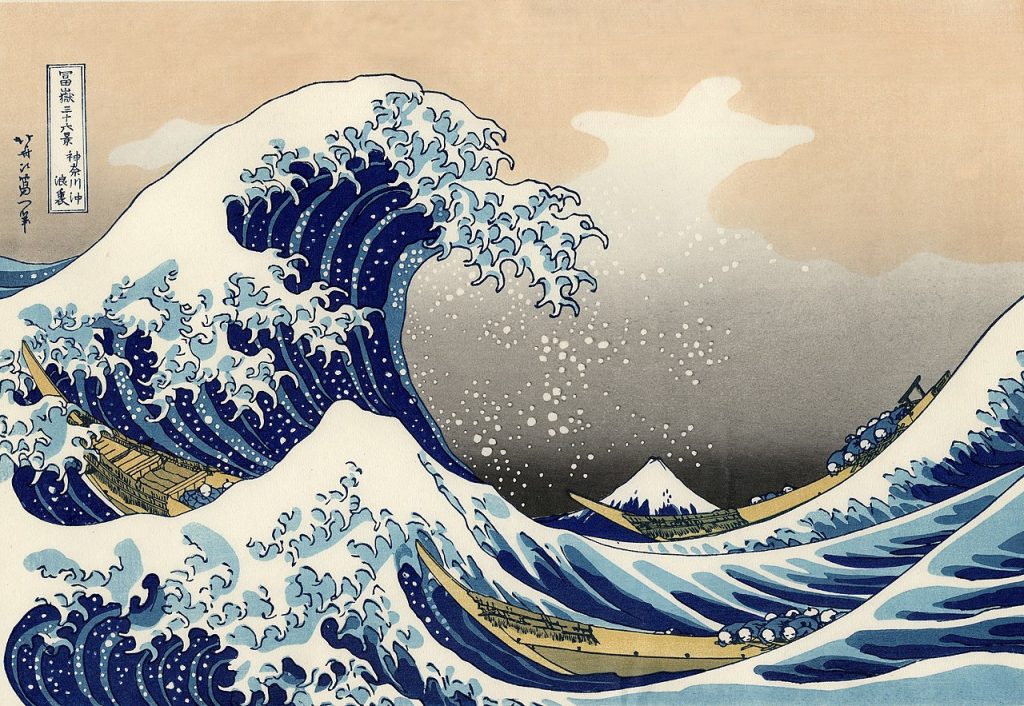
2. Publisher Marks: Tracing the Artistic Lineage
The collaborative nature of ukiyo-e production involves artists, woodblock carvers, and publishers. Delve into the prints’ margins, seeking publisher marks that unravel the print’s origin. Understanding the symbiotic relationship between these contributors adds depth to your discernment.
Example: Hiroshige’s “Tokaido Road” series often features the publisher Hoeido’s mark, signifying its role in bringing these prints to life.
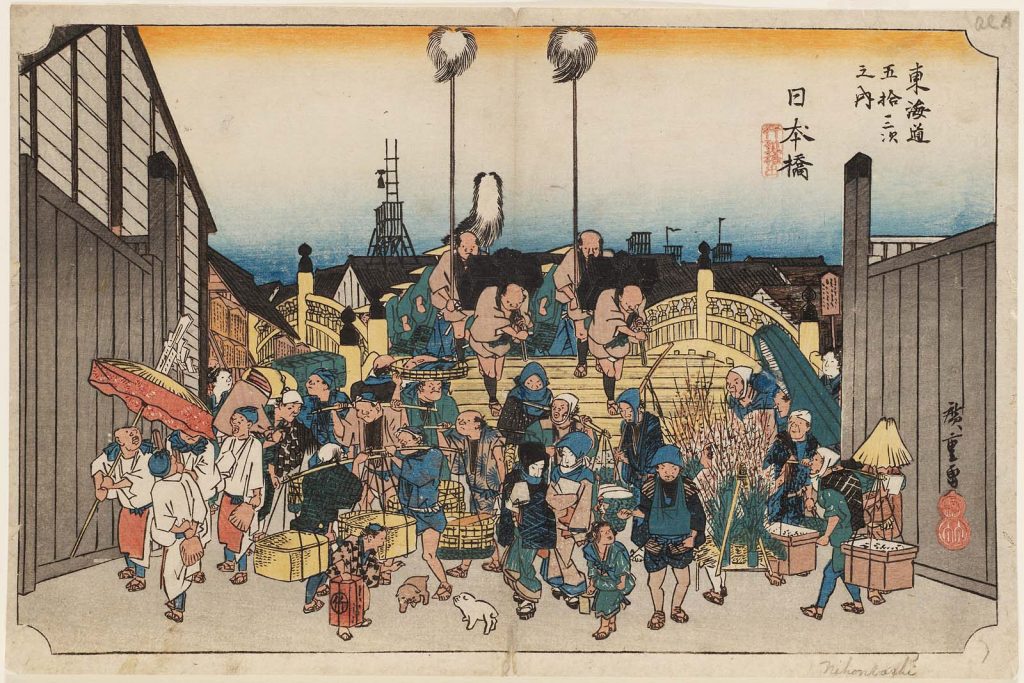
3. Color Brilliance and Paper Quality: Touchstones of Authentic Craftsmanship
Authentic ukiyo-e prints boast vibrant colors and meticulous detailing, achieved through the meticulous woodblock printing process. The texture of the paper itself becomes a silent storyteller. As a novice collector, relish the nuances of color brilliance and paper quality, letting your senses guide you.
Example: Utamaro’s bijin-ga prints, like “Three Beauties of the Present Day,” showcase the artist’s mastery in portraying subtle gradations of color and intricate patterns on fabric.
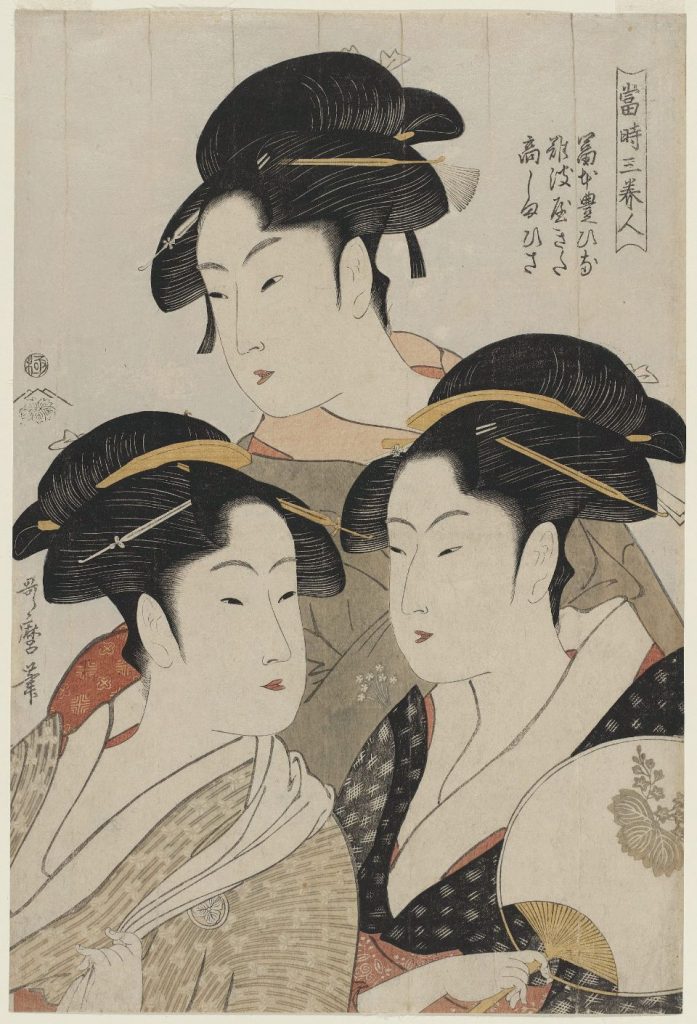
4. Condition Evaluation: Navigating the Sands of Time
Ukiyo-e prints have weathered the years, and assessing their condition is integral to informed collecting. Beware of foxing, discoloration, or damage that might compromise the print’s aesthetic and historical value.
Other conditions that can negatively impact the price are presence of a centerfold, tape marks, trimmed borders, pinholes, stains, and visible woodgrain.
Example: Hiroshige’s “Fifty-three Stations of the Tokaido Road” series, when well-preserved, allows for a journey through time with minimal wear and tear.
5. Other Factors Impacting Ukiyo-e Price
Several other subjective factors can have an impact on the price of a ukiyo-e print.
These include:
Provenance: who owned the print before it was put on sale? Famous or historically significant previous owners can significantly impact the price. For example, Freddie Mercury was an avid collector of Japanese art, and the sale of some of his collection at auction fetched record prices.
Composition: what is the subject of the ukiyo-e print? You’ll find that artwork that includes Mount Fuji, bodies of water, weather elements like rain or snow, or notable people can influence the value.
For example, here are 6 of the Most Prominent Mount Fuji Ukiyo-e Art Prints.
Age: when was the ukiyo-e print made? Not only are earlier works of the ukiyo-e era (early to mid 1800’s) generally more valuable, but earlier editions of the same print can command more.
Art Market Economics and Trends: macro-economic and seasonal factors influence the art market. For example, prices were more depressed during COVID but have been rising steadily to pre-COVID levels. Ukiyo-e art in particular has seen a resurgence, but as with any market there will price peaks and valleys. If you are interested in the trading of ukiyo-e art, keep an eye on auctions selling prints you have shortlisted. Procure them when prices are competitive so that you can put them for auction as part of a collection when the market is high.
Embarking on Your Ukiyo-e Collection Journey: Practical Tips
1. Start Small, Dream Big: Gradual Expansion
Begin your collection with prints that resonate with your aesthetic preferences and gradually broaden your scope. This approach allows for a curated collection, echoing your evolving taste and understanding.
2. Learn from Experts: Cultivate Knowledge
Attend exhibitions, engage with seasoned collectors, and dive into publications dedicated to ukiyo-e. The more you immerse yourself in the world of Japanese art prints, the more confident you’ll become in navigating its intricacies.
3. Auction Adventures: Bidding Wisely
Explore reputable auction houses specializing in Asian art. Bidding at auctions not only adds a thrill to your journey but can also unveil hidden treasures for your collection.
Example: The 2023 Christie’s auction of Hokusai’s “Under the well of the Great Wave off Kanagawa” in a rare prime condition saw fervent bidding amongst six potential buyers, ultimately fetching a record-breaking price of $2.76 million.
Ukiyo-e in Contemporary Spaces: Breathing Life into Your Collection
Ukiyo-e prints aren’t relics confined to history; they seamlessly integrate into modern spaces, injecting a touch of timeless elegance. Embrace the versatility of ukiyo-e by:
1. Creative Framing: Merging Tradition with Modernity
Experiment with framing options that complement your interior aesthetic. Consider floating frames or minimalist designs that showcase the intricate edges of these historical prints.
2. Thematic Displays: Crafting Visual Narratives
Group prints thematically to tell compelling stories on your walls. Create a curated gallery wall that reflects specific periods, artists, or themes within the vast ukiyo-e landscape.
Example: Displaying Hiroshige’s “One Hundred Famous Views of Edo” as a series offers a visual journey through the vibrant tapestry of Edo-era Tokyo.
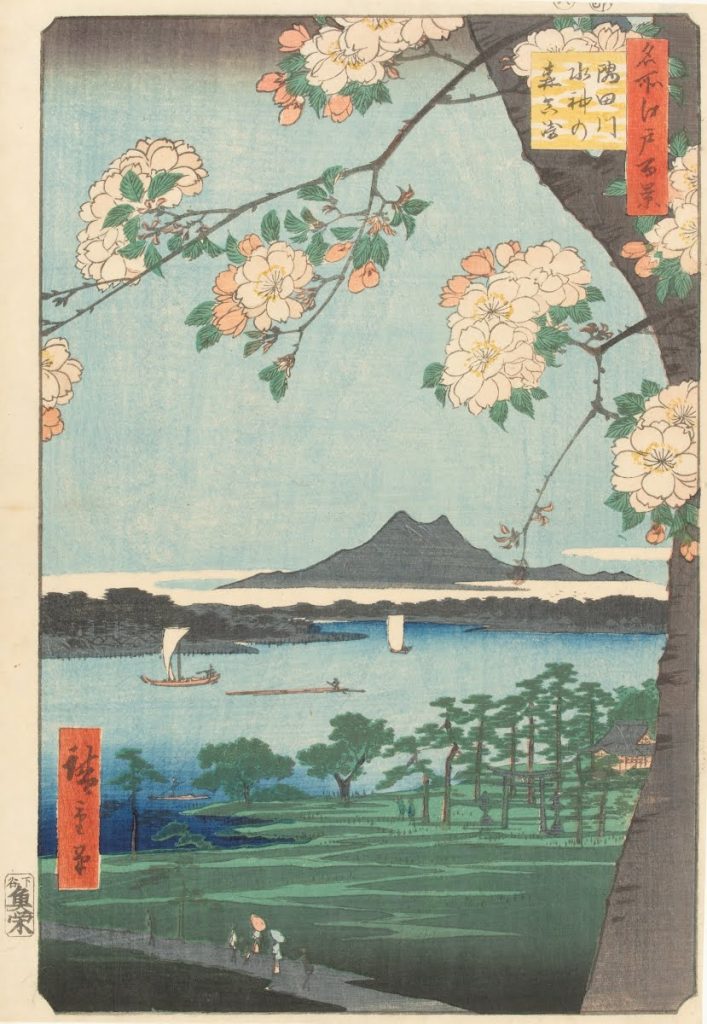
3. Fusion of Cultures: Ukiyo-e Meets Contemporary Art
Explore modern artists influenced by ukiyo-e and incorporate their works into your collection. This fusion seamlessly bridges the gap between traditional and contemporary artistic expressions.
Example: Yoshitomo Nara‘s contemporary take on ukiyo-e elements creates a fascinating dialogue between past and present. His artwork entitled UKIYO shown below sold at a Sotheby’s auction for approx $193,000.
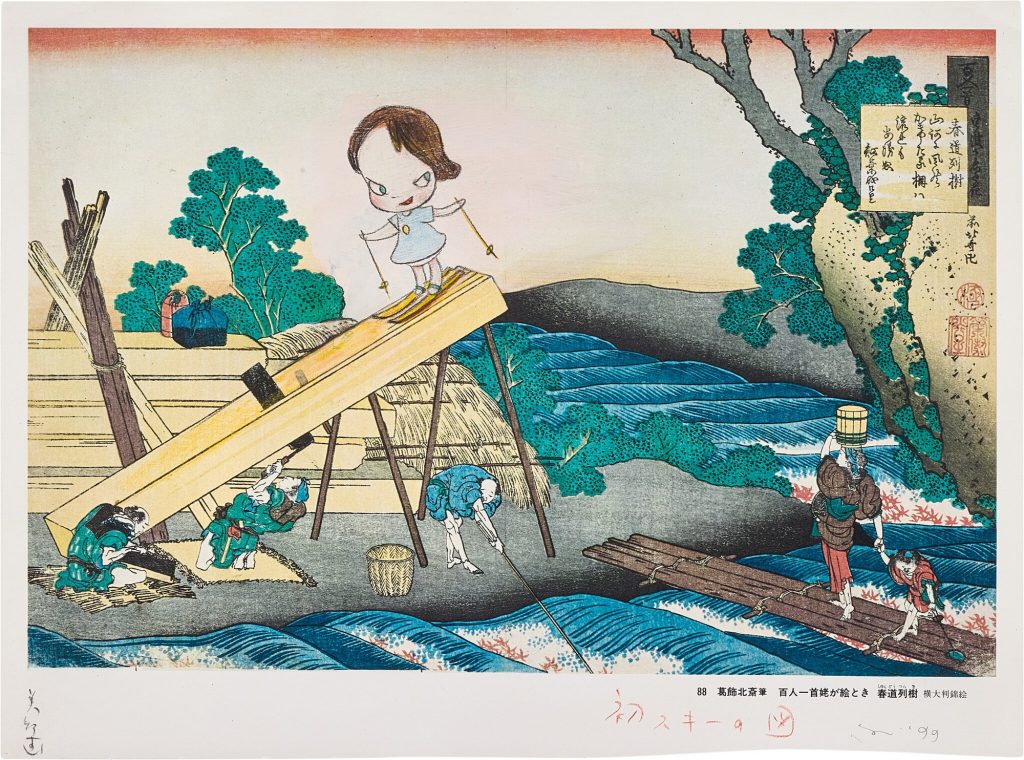
Conclusion: Collecting Ukiyo-e Art
As you embark on your ukiyo-e collection journey, remember that each print encapsulates a moment in Japan’s artistic history.
Acclimate yourself with Japanese culture and the rich history of Japanese art prints.
The world of ukiyo-e is vast and diverse, offering a treasure trove for collectors seeking not just art but a profound connection with Japan’s rich cultural heritage.
Read more:
- Where Can I Buy Ukiyo-e Art? Here’s where to find those rare prints
- 9 Reasons for the Importance of Mount Fuji in Japanese Culture
- Mori Yuzan and Hamonshu: Japanese Wave Designs
- The Serenity of Circles: Exploring the Importance of Circles in Japanese Art and Culture

At the Art of Zen we have a wide selection of original Japanese art prints in the ukiyo-e and Japandi style. Some of our best selling work is Mount Fuji wall art and Japandi wall art.
Add some zen to your space with some art from the Art of Zen shop.
Featured image at top of Sudden Shower over Shin-Ohasi Bridge by Hiroshige.
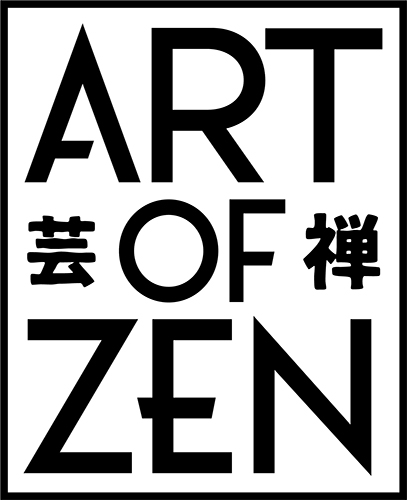
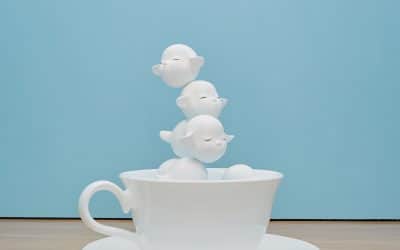
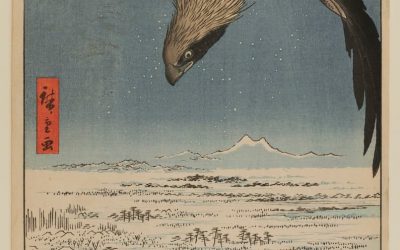
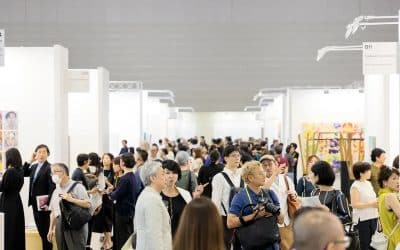
0 Comments